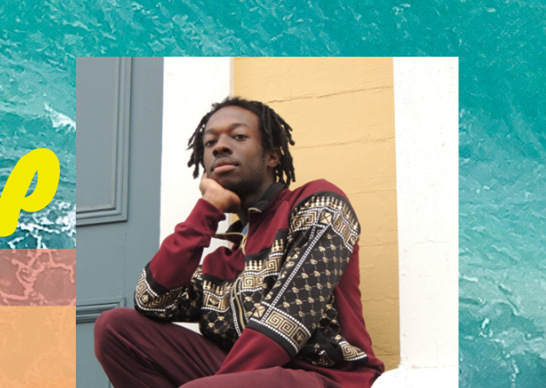New Haven choreographer embraces true self through dance
By Quinn Roberts
When you think of vogue and ballroom culture, you may think of fame and fortune – RuPaul, Beyoncé, Madonna, all these glamorous, wealthy Hollywood stars. You might be vaguely aware of vogue’s origins in queer, black communities, and you might want to try it out for yourself, but you look on TV and shake your head. How could you ever dream of looking so fierce?
Anthony Duff Jr. is here to change the narrative surrounding vogue and ballroom dance. The New Haven-based instructor hosts workshops across Connecticut, including at the New Haven Pride Center. His hope, he says, is to create a space where vogue can be separated from profit-driven exploitation and misrepresentation, and where queer people of all backgrounds and identities can build self-love and shared community values. Here, Duff shares offers a glimpse into his passion and inspirations.
Q: What is your history with vogue/ballroom culture? What is it about vogue that you love so much?
A: My personal history with ballroom culture started when I saw the movie “Paris is Burning” [the 1990 documentary that chronicled New York City’s drag scene during the 1980s]. Like many people who grew up with no representation for black and brown queer and trans people, that’s where much of it starts. For ballroom to be presented to me through such a powerful film, I was immediately enthralled to see a space that is specifically designed for us. From that movie, I grew a love and passion for vogue.
I love seeing people expressing their unadulterated selves and being confident. It was a feeling that I had been deprived of growing up. To learn to vogue was a huge stepping-stone to fully embracing who I am as a person. And I felt that among other categories and art forms from ballroom, vogue stuck with me because it’s a sensation that lingers in the muscles. Many people with an affinity for dance will say that the muscles don’t forget it. The same way you remember how to drive, that’s the way I feel when I vogue. What I love most about vogue fem is that the elements give you structure, so no matter what, you look good, but I also find that the moves are soothing for the body. It simply feels good to vogue. It can be graceful, it can be passionate, it can be exaggerated but also minimal.
Ballroom culture is so intricate. It was underground for decades but the fact that it is becoming more popular had nothing to do with my interest; it was the feeling of family that it gave me. Many times in my life I’ve hidden certain parts of myself from my family, but ballroom allowed me to recognize those parts as aspects of me as a whole.
Q: Queer communities of color have historically attached a social objective to vogue. For many queer youths, the houses were not just figurative shelters, they were literal shelters too. Do you have a social/political objective to your voguing practice?
A: There are plenty of social issues that affect black people, both LGBTQ and non-LGBTQ, regarding access to employment, access to education, access to basic resources. That was what I wanted to combat prior to becoming familiar with the ballroom community. Now, I view vogue as an instrument for addressing the social issues, but in a more personal way. People think activism is just marching, picket lines, shouting, screaming, and chanting. While that exists, there is also a more individual and artistic activism that is less visible.
Vogue is a type of activism that involves embracing who you are and foregrounding your marginalized identity. It is definitely political, because we are implicitly told on a day-to-day basis that we are “less than.” We are “second-class citizens” in the eyes of those who hold power. I am fighting that by actively deciding to love myself. A major part of that is presenting myself as a man who can be flamboyant. Black men are allowed to be flamboyant when it’s funny, but I also embody this when it’s not funny. I cannot change something that is so innate. By giving visibility to ballroom, I am in a small way connecting people to an LGBTQ-affirming space.
Q: Where do you seek inspiration for your choreography and lessons? How do you stay motivated and inspired as an artist?
A: I watch hundreds if not thousands of vogue performances regularly, both old and more recent, on social media and the Internet, but most importantly by going to the balls. Much of my inspiration does not solely come from watching others vogue, although most of it does. When I see dramatic expressions of emotions, that can be translated into vogue. At a cultural level, we use gestures but only after we give meaning to them. When the City Girls say “period” and swipe their hands across their collarbones, we know what that means because we implicitly know what “period” means. So, if you take a gesture and perform it in a way that fits into the conventions of vogue, then it’s a move.
Most of the time, I don’t need motivation because I can’t go without vogue, just as I cannot go without drinking water. But eventually I reach a point where I don’t have the urge to get up and move, and in those times I get external motivation from seeing people vogue well. From my perspective, you can tell that vogue is being executed properly when it raises your blood pressure and makes you want to get up out of your seat. In addition, when I see someone present something that looks unique, I say, “Sheesh, look at the creativity and artistry. How am I contributing to the culture?”
Q: How would you describe your teaching style?
A: My teaching style comes from performing on a step team and having to explain different moves to the other team members. I also have experience in a traditional classroom and draw from the times that I have seen Leiomy Maldonado teach vogue. No one can deny that Maldonado is a great teacher. [Maldonado teaches at the Broadway Dance Center in New York and travels the world teaching vogue workshops and performing.]
My style of teaching involves little affirmations when people correctly pick up on what I’m doing. I want to be like a friend showing you the ropes, but also convey credibility in my execution. But if I keep explaining this, then I’ll be giving away all my secrets.
Q: What would you say to people who want to take your classes but are afraid they can’t bring it to the center?
A: First and foremost, when I started vogue I was on YouTube watching videos, and trying to copy the moves, without mirrors and without feedback. I looked a hot mess, and sometimes hot messes look cute. But it is important to take it upon yourself to start. Understand that no matter your situation, if you have a body that moves, you have what it takes to learn.
You don’t need structured training to learn to vogue. You might find that you are more comfortable imitating and practicing what you see from the confines of your home. You might also find that after practicing at home it’s time to get taught in a structured, public setting. There are multiple ways to get to the point you want to reach, and they are all valid – as long as you’re true to yourself and having a good time.







More Stories
Broadway Preview: Lewis Flinn’s Cabaret
Off-Broadway Revew: The Imaginary Invalid
Broadway Review: Call Me Izzy